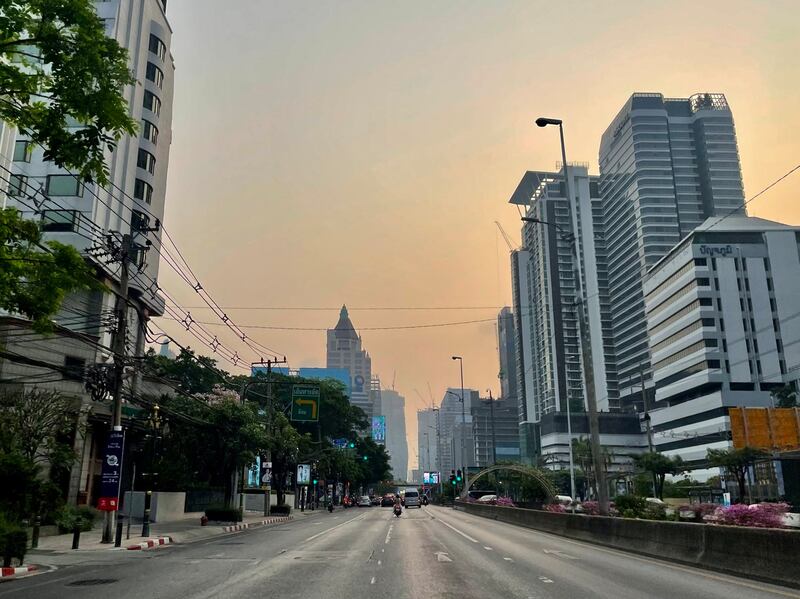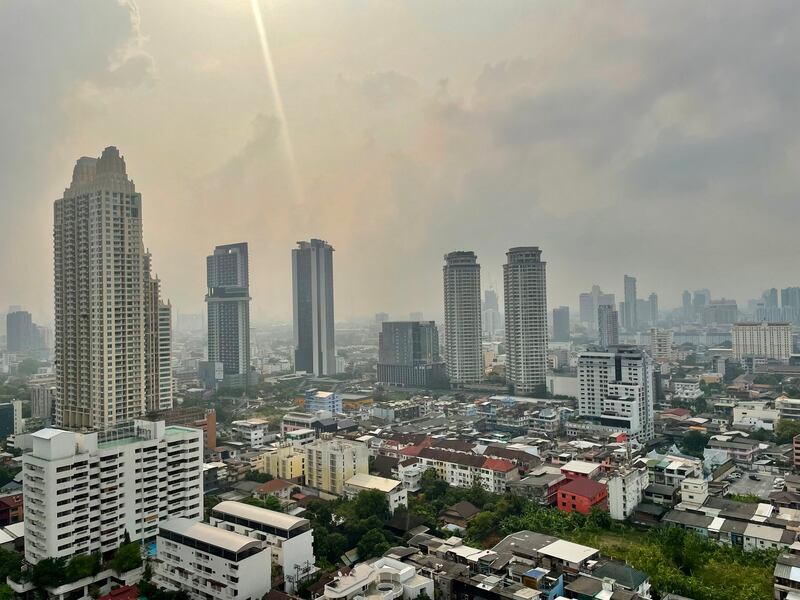Thai authorities have urged children and pregnant women to stay indoors and people to wear masks outside, as toxic smog covers vast areas of the country, leading more than one million people to seek medical attention, officials said.
Prime Minister Prayuth Chan-o-cha begged farmers to stop burning crop stubble and called for the eradication of exhaust-spewing vehicles.
Thailand’s Pollution Control Department issued a public health notice Friday asking citizens to “reduce their time doing outdoor activities and use personal protective equipment if necessary.”
Vulnerable groups, including the elderly, children, and pregnant women were told to stay indoors.
Since the beginning of the year, more than 1.3 million people in Thailand have fallen ill from air pollution, a senior public health official said Thursday, adding that more than 200,000 people were hospitalized this week alone.

“The PM2.5 level has been over 51 micrograms per cubic meter of air for more than three consecutive days in 15 provinces, which has begun to affect the people’s health,” Opart Karnkawinpong, Thailand’s public health secretary, told reporters in Bangkok.
PM2.5 are hazardous airborne particles smaller than 2.5 micrometers in diameter, which is about 30 times smaller than the diameter of a human hair. They can cause severe health problems, including respiratory and cardiovascular diseases, and cancer.
“The PM2.5 levels are higher this year compared to last two years partly because there was less travel due to the pandemic, resulting in less pollution,” Opart added.
Alliya Moun-Ob, an air pollution campaigner for Greenpeace Thailand, said the number of people who are sick due to air pollution is “scary and perhaps the worst we have seen so far.”
“We could see mountains in Chiang Mai but can’t see them anymore. In Bangkok, tall buildings are lost in the smog,” she told RFA on Friday.
“It’s the post-COVID back-to-normal situation. That is why it is particularly bad this year for Thailand. Also, there is less rain this year compared to last.”
One of the worst in Southeast Asia
Thailand ranks second in exposure to air pollution among Southeast Asia countries, according to the World Health Organization’s State of Global Air report.
Alliya said Thailand “competes with Indonesia each year to take the top spot for air pollution.”
Typically, Thailand’s air quality deteriorates during the dry season, between December and April, due to forest fires and farmers burning their fields to remove the waste.
Thai government officials and environmentalists say that open burning combined with vehicle exhaust and industrial emissions make perfect conditions for toxic smog.
Somporn Chantara, the head of the Environmental Science Research Center at Chiang Mai University, said this year’s “very poor air quality in the north is caused by the extensive burning in the region in the agricultural areas and the forest of Thailand and in neighboring countries.”
“This year’s air pollution season saw a record amount of burning across the region,” he said, referring to Myanmar, Thailand, Laos, and Cambodia.
On Thursday, Prayuth asked farmers to stop burning agricultural waste altogether after imposing a three-month ban on burning it last month.
“Please, I don’t want to use the laws. If it’s used, you all will be breaking it. I don’t want anyone to be in trouble, but you must think about the quality of life of others and their health too,” he said.
In 2019, Prayuth’s government declared tackling PM2.5 a top national priority and issued a detailed five-year smog management masterplan.
“I just looked at it today. Just about 20 out of more than 60 action plans have been implemented in four years,” Alliya said. “Nothing has been done to tackle industrial pollution, including corn cultivation that amounts to about one-third of toxic air emissions in the hot spot areas.”
Back to wearing masks again
Thailand lifted the COVID-19 masking mandate in June, but many Thais have taken to wearing masks again due to air pollution.
“I was beginning to enjoy the fresh air without masks, but the last few weeks have been horrible with pollution,” Ploy Bunnag, a university student in Bangkok, told RFA on Friday.
“This week was one of the worst I can remember. I could even feel the toxic air on my throat.”

Chiang Mai, a popular tourist city in the north, was shrouded in unhealthy air on Friday afternoon, with its air quality ranked second worst in the world, according to IQAir, a Swiss company that monitors the world’s 100 major cities’ air quality in real-time.
Beijing’s air was the worst. Yangon was third and Bangkok was fourth.
Thailand Air Quality and Noise Management Bureau’s situation report showed a 246 AQI (Air Quality Index) reading, a “very unhealthy” level, at a station in Chiang Mai at 2 p.m on Friday.
The central province of Sukhothai had the worst reading in the country with 251 AQI, primarily due to agricultural burning, while most of Bangkok showed “unhealthy” levels above 101.
Assanee Buranupakorn, Chiang Mai’s mayor, said the haze issue negatively impacts people’s health and significantly influences local tourism and the economy.
“One strategy in Chiang Mai is to keep an eye out for open burning, which resulted in numerous hotspots this year,” Assanee told RFA.
He said they have also asked owners of the city’s 17 high-rise buildings to help spray water from the rooftops “to help trap smoke and dust and add moisture to the air.”
The World Health Organization has recommended that average annual readings of PM2.5 should be no more than 5 micrograms per cubic meter. IQ Air said Thailand’s reading was 20.2 micrograms per cubic meter in 2021.
According to WHO’s State of Global Air report, air pollution was among the top 10 reasons for death in Thailand in 2019, accounting for nearly 8% of all deaths (more than 41,000 cases), with PM2.5 ranked as the top risk for such deaths.
Kunnawut Boonreak in Chiang Mai contributed to this report.
Edited by Mike Firn.

